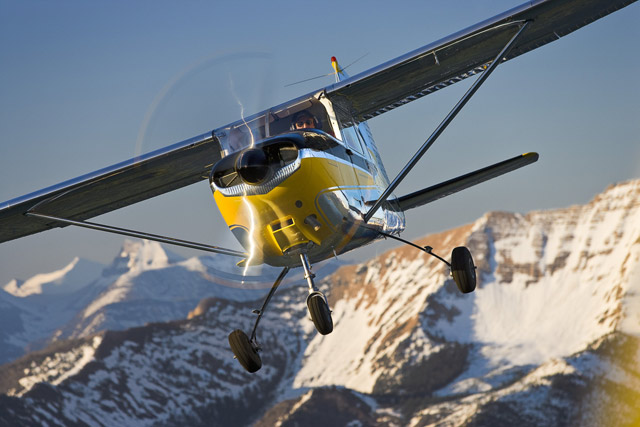
Colorado mountain flying instructors school us
Fellow flatlanders—mountain-trained pilots are welcome to read along—here’s what we are doing wrong. We’re not getting training.
I asked mountain flying instructors in Colorado how we can improve our mountain flying skills. Bill Standerfer and Bill Dunn, who teach for the Colorado Pilots Association; instructor Levi Brown of a newly formed flight school at Lake County Airport (elevation 9,934 feet) in Leadville; and Gary Kraft of Aspen Aero at Aspen-Pitkin County Airport (elevation 7,815 feet) at Aspen all weighed in.
Standerfer recalled a pilot in June 2014 who decided to fly from Denver above Interstate 70 through the Loveland Pass (elevation 11,991 feet) in a Piper Cherokee 235. Like many before him, he was unable to climb above terrain and tried to turn back toward Denver, but all aboard were killed when the aircraft crashed near the beginner’s slope of the Loveland Ski Area. The Rawlins Pass (elevation 11,660 feet) would have been a better choice, Standerfer said.
Standerfer’s course includes a day in the classroom at Broomfield, Colorado, 40 minutes by car from Denver International Airport, and a day flying in the client’s aircraft. “I won’t sign them off until we go to Leadville,” Standerfer said.
At Leadville, airport manager and mountain flying instructor Brown has just purchased a Cessna 182 Skylane for his new flight school, the Blue Manx. (The owners are from the Isle of Man, where the people are called Manx.) He plans to offer a mountain flying course that includes two to three flights, including visits to nearby airports such as Aspen. Aspen is only 24 nautical miles away, but there is a 13,400-foot mountain in the way. (The highest mountain near the airport is 14,400 feet. FAA regulation 91.211 requires a pilot to use oxygen when above 12,500 feet for more than 30 minutes.) Brown says we not only fail to understand density altitude at his airport, we flatlanders argue against it.
Aircraft owners tell him their airplane won’t start, and he tells them to lean the mixture. It works. They land but their engine quits at taxiway Delta. “I drive out and tell them what’s going on,” Brown said. They lean the mixture and it works. A Cirrus owner taxied to the end of the runway and came back, saying there was something wrong with his engine. Brown told him to lean the mixture and he replied that couldn’t be it. He called his mechanic. The mechanic said, “Lean the mixture.” It worked. “They look confused when I tell them their mixture is too rich,” Brown said. It happens twice a week all summer, he said.
“They get scared when they see they are not getting a climb of 500 feet per minute,” Brown said. The pilots turn on course before reaching 500 feet and discover a new problem—terrain slopes upward to the north.
Standerfer noted that when you’re in a single-engine airplane in the Rockies, you’re flying in the terrain, not above it, and GPS Direct is not a good idea. Nowhere is that more true than at Aspen, where mountain flying instructor Kraft operates Aspen Aero—Aspen’s Mountain Flying School. Kraft’s number-one concern is that flatlanders won’t look at their charts because out the window, “Everything looks the same,” Kraft said. Flatlanders get lost in the back valleys. Within 10 minutes of taking off from the Aspen airport, Kraft can show you some valleys that will curl your headset.
Once lost in the Rockies—and that is as scary as it sounds—many flatlanders have no escape plan. “Have a Plan B and C,” he said. If there is a Plan B to return to safe terrain, flatlanders seem reluctant to use it early enough to escape their problems, which include wind and rapidly changing weather.
“Be up on gusty crosswinds and rapidly changing airport conditions,” Kraft said. When I flew with him years ago, our training flight was wisely delayed by higher-than-forecast winds. The weather was sunny and beautiful. What could possibly go wrong?
You may find winds are too dangerous to land, but you can’t safely go around for another attempt. “For an underpowered aircraft, a go-around is not an option,” Kraft said. “At Aspen, when strong spring winds are out of the southwest you have to land to the south on Runway 15. There are strong downdrafts around the hills. One day we were barely able to out-climb them in a Cessna T210.” Imagine flying at Aspen on that day in a less-powerful aircraft.
“Knowing the winds aloft is critical,” Kraft said. “If it is 20-plus knots, pay attention to the ridgelines.”
Fellow flatlanders, seek a higher education.
Email [email protected]
Take the AOPA Air Safety Institute course on mountain flying.
Mountain pass weather
Many of the Colorado mountain passes have automated weather reporting stations in them. On the day this was written, winds at Berthound Pass were 39 gusting to 47 miles per hour, while winds in Monarch Pass were 44 gusting to 50 miles per hour. To see all the Colorado mountain pass reporting stations, go online. —AKM



